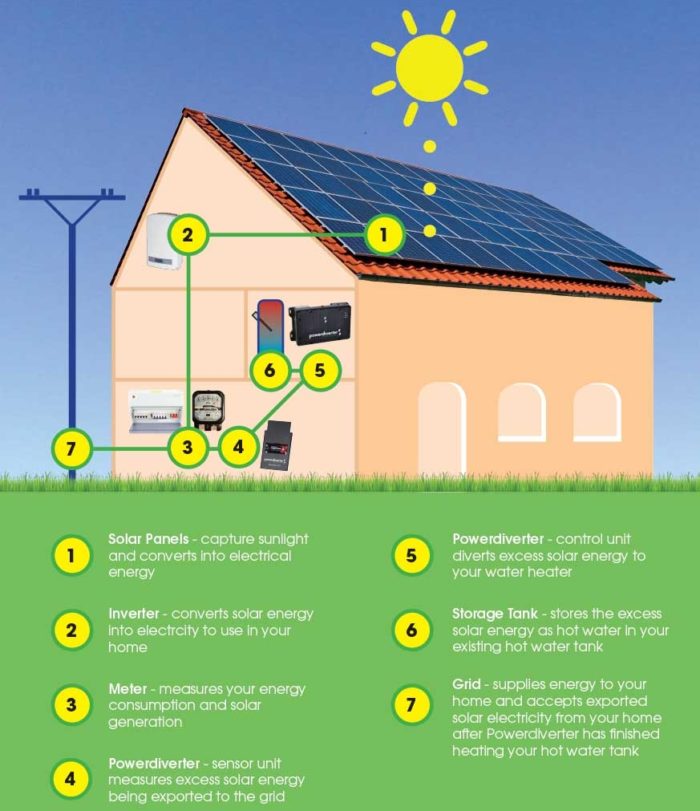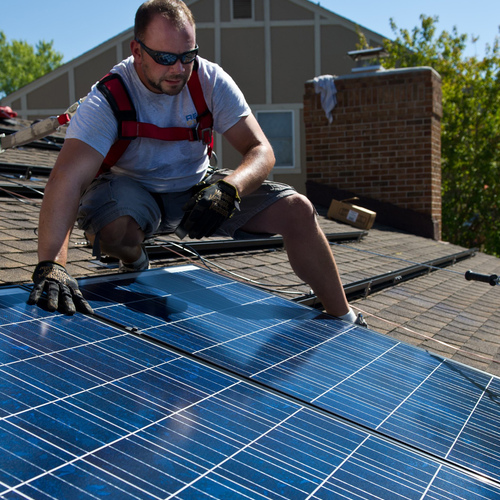
Image Credit: Image #1: PowerDiverter
In some U.S. states, electric utilities refuse to offer a net-metering agreement to owners of PV systems. Instead of a net-metering agreement — an arrangement that provides a homeowner with a one-for-one credit for every kilowatt-hour (kWh) of PV-generated electricity fed into the grid — these utilities want to sell electricity to users for 12 cents or 15 cents per kWh, while buying it back for only 4 or 5 cents per kWh.
From the utilities’ perspective, there is a legitimate business case behind this apparent unfairness. Utility representatives point out that their companies deserve to be paid for the costs of maintaining the grid — so it’s only fair for the utility to buy electricity at a relatively low wholesale price while selling it at a relatively high retail price.
The issue is debatable, of course. GBA has published many articles analyzing whether (a) net metering contracts provide valuable benefits to utilities (for example, by reducing the utility’s dependence on expensive natural gas “peaker plants” to meet peak load demands on summer afternoons) or whether (b) net metering contracts are a threat to utilities’ very survival. (See, for example, Maine Completes Value of Solar Study; Residential Solar in Nevada Benefits All, Study Says; and New York Proposes New Rates for Distributed Energy.)
In this article, I don’t intend to address the debate over the fairness of net metering. Instead, I’ll look into ways that homeowners living in states without net metering can use their excess PV power on site instead of selling it to utilities at a very low price.
Installing a battery
When faced with the dilemma described above — the unwillingness of the local utility to provide full credit for power fed into the grid — many homeowners think, “Well, I’ll just install a battery.” The idea makes sense:…
Weekly Newsletter
Get building science and energy efficiency advice, plus special offers, in your inbox.

This article is only available to GBA Prime Members
Sign up for a free trial and get instant access to this article as well as GBA’s complete library of premium articles and construction details.
Start Free TrialAlready a member? Log in















17 Comments
It's far more than just a peak power energy cost reduction
"...net metering contracts provide valuable benefits to utilities (for example, by reducing the utility’s dependence on expensive natural gas “peaker plants” to meet peak load demands on summer afternoons) or whether (b) net metering contracts are a threat to utilities’ very survival."
More valuable than the offset of energy costs from peaker plants, net metered PV is paying for increased distribution grid throughput without having to upgrade the capacity of the distribution grid, and lower transmission grid congestion during peak load periods. Upgrading grid capacity is VERY expensive stuff, and in the "electrification of everything" scenario there simply isn't enough grid capacity to provide it all via the grid as-is. But with distributed PV the mid-day and afternoon peak loads that have to get across substations and out the local distribution grid is reduced. Much of the power produced on the rooftop is consumed behind the meter, with no power flowing over the grid, and power exported to the grid during excess is usually consumed by other houses & businesses connected to the same transformer. Adding even a tiny amount of smarts can make the existing distribution grid work more effectively with much higher total kwh moving over the existing transformers and wires.
But clearly the value of any particular PV rooftop to the utility or grid operator varies by location. In the Brooklyn-Queens NY substation case it was fairly easy to rationalize subsidizing PV in particular neighborhoods to relieve load rather than re-building the substation for higher capacity, saving the ratepayers at large over USD$1B. (see: https://insideclimatenews.org/news/04042016/coned-brooklyn-queens-energy-demand-management-project-solar-fuel-cells-climate-change ) That very high grid-locational value isn't going to be the same everywhere, but it's still going to have at least some value anywhere on the grid.
The recent reversal of the Nevada rejection of net metering, and the recent net-metering plan taken up in New Hampshire shows a lot more sophistication is entering the process in the US, unlike the ham-fisted approaches taken in Australia in the past half decade.
http://www.utilitydive.com/news/lessons-from-nevadas-rooftop-solar-victory-consumer-demand-and-collaborat/446518/
The recent Australian policy approaches have come close to guaranteeing the bankruptcy of the utilities, now that 23% of all homes in Australia have rooftop PV (despite the low to zero remuneration for the power exported to the grid), and batteries to prevent export are reaching no-brainer investment levels, a combination of lower battery pricing and increased retail power pricing as the utilities & grid operators struggle to pay off their sunk costs with shrinking kwh sales. It has gotten bad enough that SonnenBatterie has a series of 8-12kwh batteries that they're happy to lease at low rates to homes with existing PV, saving the homeowner hundreds or even thousands of dollars per year (depending on the utility.) It's being explicitly marketed as the "Utility Killer", complete with peer-to-peer electricity trading capabilities (you can buy power from you're neighbor's PV, bypassing the utility even while using the pre-existing wire.)
http://reneweconomy.com.au/sonnen-battery-storage-plan-to-take-utilities-out-of-business-90595/
Utilities & regulators in the US need to take that lesson to heart sooner than later. Screwing the PV owners out of the value provided to the grid by distributed PV with parsimonious net metering or high fixed connection charges will backfire in a serious way.
BTW: In Australia solar thermal water heating is fully viable, and is competitive with heat pump water heaters. Most of Australia has low to no freeze risk, and really dumbed-down and simple solar water heaters are available at pricing far less than the necessarily freeze-protected North American systems. The simplicity of the cheaper solar water heaters also makes them more reliable.
Response to Jon R
Jon,
These PV diversion schemes only work with a pure resistive load. You can't hook up a heat pump to a solar diverter.
If you want to power a heat pump of any kind, you need grid power -- and if you have PV, a heat pump would only work with a PV system that exports surplus power to the grid.
A device used to divert power
A device used to divert power to a heat pump would require a different design than one for a resistive load. But with the same conceptual function. No idea if someone sells one.
> If you want to power a heat pump of any kind, you need grid power...
Unless you are including small, single residence grids, we will have to disagree on this one.
Response to Jon R
Jon,
If the heat-pump water heater draws 1,600 watts, then you can't supply power from a PV array to the device until you have 1,600 watts of surplus power. This watt output will change every few minutes, as clouds drift across the sun, making watt output variable and squirrelly.
That's not a problem with a resistive load. If you want to operate a heat pump directly from PV, with no grid connection, you would need a large battery -- which makes the setup expensive (and not cost-effective).
And if you have 2KW of excess
And if you have 2KW of excess power, you can reasonably connect a 1KW heat pump, even if some other loads come and go. Not to mention that some heat pumps (like Chiltrix) have modbus controls such that you can control how much current they consume (enabling variable load - like a resistive load). And when it comes to limiting export to the grid, a few seconds (maybe minutes) of surge or reaction time is a non-issue. The goal is a reasonable, not perfect fit between optional loads and excess production.
Offgrid PV systems require batteries. But once you have them, running a heat pump while sufficient excess PV power is available adds no extra load to said batteries. No additional battery cost.
Response to Jon R
Jon R,
I stand by my analysis. The point of the article is to discuss solutions for homeowners want a low-cost way to use excess PV power without selling the power to the grid, and without incurring the high cost of batteries.
A resistive load will work in these circumstances; a non-resistive load like a high-wattage heat pump won't. Excess PV power -- PV power worth doing something with -- won't always be 2,000 watts of power. It will often be 50 watts of power. And excess PV production often happens on days when blowing clouds make the power output of the system highly variable.
Variable speed heat pumps can work
Martin, I think Jon has a good point about heat pumps. If you want to only list products that are available for purchase in North America today, you don't have much to list for either approach. But if you want to talk about what could work, the Chiltrix input power range is almost 8:1, which would allow capturing most of the available excess power in many system sizes. And on the fourth page of this document:
http://www.chiltrix.com/documents/Chiller-with-solar.pdf
they show a grid tied system with no batteries that uses their own controller to provide the sort of function you are talking about here. You'd need to talk to them about the details of cost and availability of that controller, but it might turn out that in North America, equipment to do this with a heat pump is more readily available than equipment to do it with resistive heaters.
It's important to note that
It's important to note that the scheme is limited by the amount of hot water used. Depends, but perhaps 10kWh/day (~$1/day saved). After that, you are back to selling to the utility at low rates.
In cold weather, the kWH diverted can be expanded by larger tanks and use of the hot water for space heating. Perhaps even using a heat pump to increase efficiency.
Response to Charlie Sullivan
Charlie,
Thanks. I've learned something.
Jon,
I stand corrected. Sorry for doubting you.
General question about net-metered payments, terminology
In most states where net-metering is permitted, do utilities typically have a different per-kWh rate for exported energy for
1) crediting customers an amount of equivalent energy, vs.
2) making actual cash payments for energy exported?
Sorry I'm not explaining this well, as I'm not sure of the terminology. I'll try an example:
We live in CA and our utility has a net-metered plan with a 12-month "settle up." Every month we pay just for the service of being connected to the grid (~$10/month), and our generation and consumption is kept on a running tally. After the 12-month period is over, if we have used more than we've generated, we pay the utility for the difference (presumably at retail rates: ~$0.15/kWh), but if we've generated more than we've used, the utility pays us for the difference, but they pay us at the wholesale price: ~$0.025/kWh. Is this typical?
Our first 12-month period ended in May 2017. We net exported 4440 kWh during that 12-month period. The "cumulative energy charge" for our 12-month period was -$835 (negative), but we only got paid $113 because it's based on the wholesale price. I often see net metering described as "allowing you to sell solar electricity you don't use to your utility for the same price they sell it to you." Can I get your thoughts on this or can you point me to another resource that discusses the prevalence of what to me appears to be net-metering shenanigans among the utilities? Thanks.
Chris
Don't the first three paragraphs of this blog deal with the difference?
Response to Chris Stratton
Chris,
1. Utilities can create any type of agreement they want on grid-connected PV systems (as long as the utility doesn't violate state regulations). Agreements differ.
2. Having a monthly minimum charge, regardless of electricity usage, is normal.
3. Your utility is generous, since you get a one-for-one credit on your PV production unless you produce more than you use on an annual basis.
4. Most utilities refuse to pay customers anything if their PV system produces more than is used on an annual basis. If you get an end-of-year check, be thankful.
responses to Martin, Malcolm
Thank you for the explanation. To your point, Malcolm, yes the beginning of the article does answer many of my questions. Martin, my apologies for missing them (they were there earlier, yes?), and sorry to derail the intent of this post. Your explanation that my utility's net metering policy is one of the best-case scenarios really puts things in perspective. It seems that to get more financial benefit from our array, we need to start using more energy. How's that for a perverse incentive?
Response to Chris Stratton
Chris,
Plenty of homeowners with PV systems are in your position. If you produce more electricity on an annual basis than you use, you should consider whether your home has any gas appliances (for example, a kitchen range, water heater, or clothes dryer). You can swap out some of these gas appliances for new electric appliances if you want.
If you've already done that, consider buying an electric vehicle.
Utility Rate Design is Hard
It requires balancing several often conflicting requirements. For regulated utilities, the rate structure is the result of political process that attempts to consider the interest of the public and the interest of the utility stockholders. The public interest include:
1a. The total collected should be no more than the utility's cost plus a reasonable return on investment.
2a. The costs should be allocated "fairly" among various customers. The definition of fair is subject to a huge amount of debate.
3a. The rates should be simple enough for a typical customer to understand with reasonable amount of effort.
4a. The rates should incentivize customer behavior that reduces the total cost.
The utility stockholder interest include:
1b. The total collected should be at least the utility's cost plus a reasonable return on investment.
2b. The costs should be allocated "fairly" among various customers.
3b. The rates should be simple enough that they don't require an army of accountants and programmers to administer.
4b. The rates should incentivize customer behavior that justifies building new capacity for which the utility will be able to earn a rate of return in the future.
The objectives are aligned on items 2 and 3 and common ground can generally be reached on item 1. Item 4 is the problem. The political process does not allow a utility that objects to a proposal on the grounds of item 4 to argue against it on that basis. Therefore, the utility comes up with arguments on the basis of items 2 and 3. Usually they pick item 2 because, for almost any proposal, you can come up with a plausible argument that it is "unfair" to someone. The regulators need to see through those arguments. Sometimes they do. Sometimes they don't.
Beyond the problem of utility objectives not being aligned with public objectives, the various objectives are often in tension with one another. Many utilities do a pretty poor job of resolving these tensions. Customers end up with perverse incentives, like grid defection or storing excess solar generation during a peak period for use at night. In my state, I have heard of customers that generate more than they use being forced to literally unplug some of their existing panels. I am pleased to see that New York is putting a lot of effort into finding some creative rate structures that do a better job. I hope they come up with results that can serve as models for others.
Be Active
Better to advocate loudly to your governor, state representatives and public service board for real net metering. Utilities are regulated monopolies who, in exchange for their monopoly status, are required to “operate in the public interest”, but they often don’t until someone raises a stink. You be that someone. Net metering is in the public interest.
If you had a choice of utilities to do business with, they would have to offer net metering in order to get your business. No one has ever ruled that the privilege of using the public as a storage battery belongs to anyone, much less the utility.
AUX BARRICADES!!
PV Diversion and Sanden HPWH
I've been contemplating the relative effectiveness of the Sanden DHW and the Sunbandit. To my ears, Charie Sullivan's post above about the Chiltrix implies that the Sunbandit setup could be even more effective if paired with a HPWH? I'm not sure if I'm reading this correctly. I wonder if the PV Diverter/Sunbandit model could be used with the Sanden CO2 HPWH. I'm not really considering doing this, just curious. At some point, I think I'd rather just forgo showering every other day than create additional complexity in the DHW system.
Log in or become a member to post a comment.
Sign up Log in